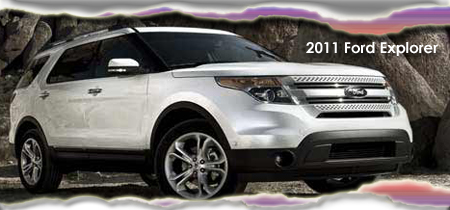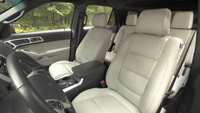
2011 Ford Explorer Test Drive
By Bob Plunkett
Ford Explorer Named 2011 International SUV of the Year
~ Most Resourceful ~
West of Austin in Texas Hill Country, we're following two-laner Rocky Road out from Blanco to log some seat time in the 2011 Explorer that looks fresh in a new square-corner package which represents a 100-percent redesign of Ford's best-selling sport utility.
For the make-over, Explorer switches from a rear-wheel-drive body-on-frame platform to a front-wheel-drive unibody structure covered in the boxy sheetmetal with a powerful new V6 planted in the engine bay, a load of electronic vehicle controls aboard for safety and a spacious cabin layout with three rows of seats for seven passengers.
 A special thanks to Bridgestone Tire for sponsoring the 2011 International Car of the Year Awards. A special thanks to Bridgestone Tire for sponsoring the 2011 International Car of the Year Awards.
Size-wise, the 2011 Explorer measures about four inches longer and five inches wider than the previous iteration.
The passenger compartment is substantially larger with total volume of 151.7 cubic feet and 80.7 cubic feet of flat-floored stow space stretching from front-row seatbacks to tail-side liftgate.
Three rows of seats are standard in all trim versions of Explorer and legroom for riders is generous -- 39.8 inches for second-row seats and 33.2 inches for a third-row split bench.
 |
Ford Explorer Named 2011 International SUV of the Year. Accepting the ICOTY Award was Ford’s Explorer Marketing Manager, Craig Patterson, center.
(l-r) Presenting the award were ICOTY jurors, Joe Wiesenfelder, senior editor, Cars.com; Courtney Caldwell, ICOTY founder and editor,
Road & Travel Magazine; Denise McCluggage, editor of denisemccluggage.com; and Mike Martini, president, Bridgestone Tire OE Americas
and ICOTY sponsor.
|
And Explorer in the new design looks too cool.
It's marked by the boxy profile with a high beltline and the roof seemingly floating above a ring of dark privacy glass. The blunt face is a smooth sweep with corner clusters of clear-lens headlamps and Ford's distinctive three-bar grille centered above the fat-lip fascia and front air dam.
Flanks house big wheels and tires as emphasized by flared wheel arches. Doors run deep to make cabin entry and exit easy and seats are elevated so all riders sit erect and in a high-hiked position for comfort and keen visibility.
At the tail the dark window rap works because rear roof pillars are tinted in black. There's a spoiler on the top edge of the big liftgate and large LED taillamp clusters dot the rear corners as two oval tailpipes protrude below the thick black fascia.
All versions employ the new monocoque structure which unites chassis and body into one cohesive unit that remains extremely rigid when set to motion. A generous wheelbase length of 112.6 inches and broad wheel track of 67 inches forge a long and broad platform which contributes to the vehicle's stability when running through a set of curves like the Texas twisties encountered during our drive time on Rocky Road.
New Explorer carries independent suspension components -- short-and-long-arm (SLA) front suspension with a thick 32-mm stabilizer bar and the rear multi-link arrangement with coil-over-shocks -- to deliver incredibly smooth ride characteristics for passengers.
A speed-sensing steering system gets electric power assistance, which eliminates a load of hydraulic equipment and contributes to the efficiency of Explorer's engine.
The spec sheet for Explorer lists lots of active and passive safety equipment.
All trim versions contain dual-stage frontal air bags for front riders with smart sensors in place to track the severity of a frontal crash along with the driver's seat position in proximity to the steering wheel and whether seatbelts are being used.
Also, there are front ratcheting headrests and seat-mounted side air bags up front plus curtain-style side air bags tucked in the headliner for outboard seats on all rows.
 A new safety option adds inflatable seatbelts to second-row seats. These devices distribute the impact forces from a sudden stop over five times the surface area compared to conventional seatbelts so they pare the pressure on the rider's chest while also helping to control motion of the neck and head. A new safety option adds inflatable seatbelts to second-row seats. These devices distribute the impact forces from a sudden stop over five times the surface area compared to conventional seatbelts so they pare the pressure on the rider's chest while also helping to control motion of the neck and head.
Active safety systems include four-wheel disc brakes tied to an anti-lock brake system (ABS) and Ford's AdvanceTrac electronic stability control device with Roll Stability Control (RSC), which measures vehicle motion on both the yaw and roll axes.
And a new electronic safety device aboard is dubbed Curve Control -- it can detect when the driver runs too fast into a turn, then automatically deploys the brakes to slow and stabilize the wagon.
For power, all trim versions of Explorer draw from a new 3.5-liter V6 engine with DOHC (dual overhead cams) and performance-enhancing Ti-VVT (twin independent variable camshaft timing) technology.
The plant produces 290 hp at 6500 rpm and torque of 255 lb-ft at 4000 rpm.
The shifter is a new six-speed electronic automatic, and a SelectShift manual controller applies to the XLT and Limited trims.
EPA estimates for Explorer's powertrain tally to 17 mpg City and 25 mpg Highway.
The optional four-wheel-drive traction system incorporates Ford's new electronic Terrain Management System (TMS) which eliminates a traditional 4WD transfer case and the familiar 4-Hi/4-Lo/4-Auto settings in favor of driver-selectable settings which automatically tune various vehicle dynamic systems to the type of terrain being covered.
From a rotary knob mounted on the center console, the driver can select four terrain settings -- one for pavement cruising with about 90 percent of the engine's torque sent to the front wheels, another for slick surfaces like snow and gravel with the system permitting less wheelspin and faster transmission upshifts, and two different off-road situations -- mud and sand.
With the sand mode, you get more throttle and less traction control so the wheels can spin more and progress forward. With the mud mode, you get more torque and less stability control so tires can plow through the goo.
Once a mode is chosen, the TMS goes to work with shift-on-the-fly quickness and total automation. The device also includes Hill Descent Control (HDC) which automatically adds engine braking when steering down a steep slope.
Explorer in base trim stocks power controls for windows and door locks and exterior mirrors, cloth seat upholstery for two front bucket seats with 6-way controls on the driver side, a second-row bench split 60/40 with folding seatbacks, the third row bench split 50/50 and folding into the floor, tilting-telescoping steering wheel, cruise control, four 12-volt power outlets, roof rails, halogen projector-beam headlamps, 17-inch steel wheels with wheel covers, and an audio kit with AM/FM/CD/MP3 and six speakers.
The XLT and Limited editions pile on additional equipment and the trappings of luxury.
Ford hones MSRP figures for the redesigned and reconfigured 2011 Explorer from a base point of $28,190.
To See All 2011 International Car of the Year Winners, click here,
For More Information on the 2011 Ford Explorer, click here.
FOR MORE ROAD TEST REVIEWS -
VISIT RTM'S NEW CAR REVIEW ARCHIVE.
|